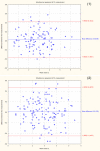Repeatability and reproducibility of quantitative cervical strain elastography (E-Cervix) in pregnancy
- PMID: 34880263
- PMCID: PMC8655038
- DOI: 10.1038/s41598-021-02498-3
Repeatability and reproducibility of quantitative cervical strain elastography (E-Cervix) in pregnancy
Abstract
Strain elastography of the uterine cervix may be useful in the diagnosis and prediction of obstetric complications. The inability to obtain quantitative results, with only the possibility of visual semiquantitative evaluation of the obtained elastograms, has been the limitation of the method thus far. E-Cervix is a software program that uses intrinsic compression to excite tissue and allows the evaluation of quantitative parameters on the basis of pixel distribution in an elastogram. The aim of this study was to assess the repeatability and reproducibility of quantitative cervical strain elastography (E-Cervix) of the uterine cervix and to assess the correlation of the obtained parameters with selected clinical features of patients in the third trimester of pregnancy. In total, 222 patients participated in the study. We assessed 5 ultrasound parameters: elasticity index (ECI), hardness ratio (HR), internal os strain (IOS), external os strain (EOS) and IOS/EOS ratio. Each study was performed according to a predetermined standardized protocol. For all assessed elastographic parameters, we obtained good intra- and interobserver reproducibility. The interclass correlation coefficient (ICC) ranged from 0.77 to 0.838 for intraobserver variability and from 0.771 to 0.826 for interobserver variability. We demonstrated a significant correlation of some obtained elastographic parameters with the basic clinical features of patients, such as age, the number of previous caesarean sections, pregnancy weight and BMI. In each case, the correlation was very low. Quantitative elastographic assessment with the use of E-Cervix is characterized by good repeatability. Some clinical features may affect the value of the parameters obtained. The clinical relevance of this interference requires further investigation.
© 2021. The Author(s).
Conflict of interest statement
The authors declare no competing interests.
Figures






Similar articles
-
Recommendations for strain elastography of the uterine cervix.Arch Gynecol Obstet. 2024 Oct;310(4):2023-2033. doi: 10.1007/s00404-024-07693-x. Epub 2024 Aug 29. Arch Gynecol Obstet. 2024. PMID: 39198283 Free PMC article. Review.
-
Reproducibility of quantitative cervical strain elastography in nonpregnant patients and the effect of vaginal misoprostol on measured parameters.Sci Rep. 2025 May 15;15(1):16857. doi: 10.1038/s41598-025-01249-y. Sci Rep. 2025. PMID: 40374741 Free PMC article.
-
Reliability of strain elastography using in vivo compression in the assessment of the uterine cervix during pregnancy.J Perinat Med. 2020 Mar 26;48(3):256-265. doi: 10.1515/jpm-2019-0370. J Perinat Med. 2020. PMID: 32083451
-
Quantitative elastography of cervical stiffness during the three trimesters of pregnancy with a semiautomatic measurement program: A longitudinal prospective pilot study.J Obstet Gynaecol Res. 2020 Feb;46(2):237-248. doi: 10.1111/jog.14170. Epub 2019 Dec 9. J Obstet Gynaecol Res. 2020. PMID: 31814257 Clinical Trial.
-
Elastography of the uterine cervix in gynecology: normal appearance, cervical intraepithelial neoplasia and cancer. A systematic review.Med Ultrason. 2021 Feb 18;23(1):74-82. doi: 10.11152/mu-2646. Epub 2020 Aug 18. Med Ultrason. 2021. PMID: 32905569
Cited by
-
Cervical elastography at 18 to 23 weeks to predict spontaneous preterm birth in individuals with a history of preterm birth.AJOG Glob Rep. 2025 Feb 16;5(1):100462. doi: 10.1016/j.xagr.2025.100462. eCollection 2025 Feb. AJOG Glob Rep. 2025. PMID: 40103845 Free PMC article.
-
Repeatability and Reproducibility of Potential Ultrasonographic Bishop Score Parameters.J Clin Med. 2023 Jul 5;12(13):4492. doi: 10.3390/jcm12134492. J Clin Med. 2023. PMID: 37445532 Free PMC article.
-
Recommendations for strain elastography of the uterine cervix.Arch Gynecol Obstet. 2024 Oct;310(4):2023-2033. doi: 10.1007/s00404-024-07693-x. Epub 2024 Aug 29. Arch Gynecol Obstet. 2024. PMID: 39198283 Free PMC article. Review.
-
Advances in the clinical application of ultrasound elastography in uterine imaging.Insights Imaging. 2022 Sep 4;13(1):141. doi: 10.1186/s13244-022-01274-9. Insights Imaging. 2022. PMID: 36057675 Free PMC article. Review.
-
Role of Cervical Elastography in Predicting Progression to Active Phase in Labor Induction in Term Nulliparous Women.Diagnostics (Basel). 2025 Feb 19;15(4):500. doi: 10.3390/diagnostics15040500. Diagnostics (Basel). 2025. PMID: 40002651 Free PMC article.
References
-
- Bishop EH. Pelvic scoring for elective induction. Obstet. Gynecol. 1964;24:266–268. - PubMed

